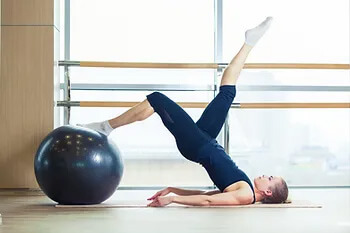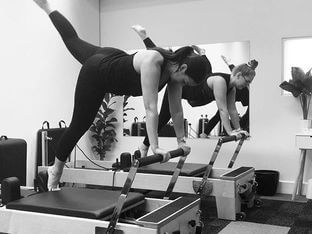With our 30 day pilates challenge starting today, we thought we would take a look at why we love pilates so much for our patients, and what some of the benefits are. Part 1 looks at how pilates affect those with chronic lower back pain. Part 2 looks at the difference between mat and reformer pilates and part 3 looks at how often is required to see the benefit of pilates.
SUMMARY:
- Back pain is extremely common, multifactorial, and often reoccurs
- Strengthening interventions appear better for long term suffers of lower back pain
- Pilates has been shown to improve muscular strength and endurance of key pelvic and postural musculature associated with lower back pain
- Specifically, pilates promotes the restoration of the function of muscles involved in lumbopelvic stabilisation, that is, transversus abdominis, multifidus, diaphragm and pelvic floor muscles
- As little as 2 sessions per week for 6 weeks has been shown to see improvements in pain and function for those with longstanding lower back pain, even after stopping pilates
Chronic low back pain (CLBP) is one of the commonest musculoskeletal problems in modern society (Anderson 1999) and is a highly prevalent in both the sporting and general public. CLBP is experienced by 70%–80% of adults at some time in their lives (Crombez et al 1999) and as such, the costs associated with LBP and related disability are enormous, causing a major economic burden for patients, governments and health insurance companies (Dagenais 2008).
Lower back pain has been one of the most extensively studied musculoskeletal conditions as a result of the prevalence and debilitation nature. Its management comprises a range of different intervention strategies including surgery, drug therapy and non-medical intervention like rehabilitation (Paolucci et al 2018). Within Physiotherapy, exercise therapy is probably the most commonly used intervention for the treatment of patients with chronic non-specific LBP due to its plausible biological rationale and low cost.
Whilst general conditioning programs to train strength and endurance of the spine musculature have been shown to reduce pain intensity and disability (Rainville et al 2004), the popularity of pilates (both mat and reformer) has helped provide an accessible and supervised form of therapeutic exercise.

EVIDENCE FOR PILATES
The Pilates method, using functional exercises aims to improve muscular strength and endurance. Specifically, the pilates method have promotes the restoration of the function of muscles involved in lumbopelvic stabilisation, that is, transversus abdominis, multifidus, diaphragm and pelvic floor muscles. Using the principles of progressive overload, your body adapts to the incremental loading week after week and consequently results important postural control improvement. In 2009, Curnow and colleagues showed that the Pilates method improves load transfer through the pelvis, something that intuitively helps those with CLBP.
However, a systematic review (Patti et al 2015) reported evidence that Pilates method-based exercises are more effective than no treatment or minimal physical exercise interventions in the management of chronic nonspecific LBP. Further, they pointed out that the effects of the Pilates method are only proven for patients with chronic nonspecific LBP in the short term.
A recent study by Natour and colleagues (2015) showed that the group of participants that were practicing Pilates method resulted statistically better compared with the a non exercising group who only used inflammatory medication. Those who were in the pilates group used less pain medication at 45, 90 (conclusion of the Pilates method), and 180 days, 90 days after the conclusion of the exercise program.
In conclusion, Pilates as an exercise choice is more effective than minimal physical exercise or drug based interventions in reducing pain and disability in the short-term period. There is agreement that exercise “helps” in the treatment of chronic pain, but it is still not clear exactly which factors or particular kind of exercises may be responsible of such improvements (Natour et al 2015; Patti et al 2015). Praxis Physiotherapy has always been a strong proponent of movement and loading early in rehabilitation (more on this in later blogs!).
In the next instalment, we discuss the difference between mat and reformer pilates and perhaps find some more answers regarding which exercise regime reigns supreme!
Check out all our other reformer pilates services on our website
Until next time,
Prevent. Prepare. Perform.
References:
- Andersson GB. Epidemiological features of chronic low-back pain. Lancet. 1999;354(91789178):581–585.
- Crombez G, Vlaeyen JW, Heuts PH, Lysens R, Crombez G. Pain-related fear is more disabling than pain itself: evidence on the role of pain-related fear in chronic back pain disability. Pain. 1999;80(1-2):329–339.
- Dagenais DC, Caro J, Haldeman S. A systematic review of low back pain cost of illness studies in the United States and internationally. The Spine Journal 2008;8(1):8‐20.
- Paolucci, T., Attanasi, C., Cecchini, W., Marazzi, A., Capobianco, S. V., & Santilli, V. (2019). Chronic low back pain and postural rehabilitation exercise: a literature review. Journal of pain research, 12, 95.
- Rainville J, Hartigan C, Martinez E, Limke J, Jouve C, Finno M. Exercise as a treatment for chronic low back pain. Spine J. 2004;4:106-115
- Patti, A., Bianco, A., Paoli, A., Messina, G., Montalto, M. A., Bellafiore, M., … & Palma, A. (2015). Effects of Pilates exercise programs in people with chronic low back pain: a systematic review. Medicine, 94(4).
- Curnow, D., Cobbin, D., Wyndham, J., & Choy, S. B. (2009). Altered motor control, posture and the Pilates method of exercise prescription. Journal of bodywork and movement therapies, 13(1), 104-111.
- Natour, J., Cazotti, L. D. A., Ribeiro, L. H., Baptista, A. S., & Jones, A. (2015). Pilates improves pain, function and quality of life in patients with chronic low back pain: a randomized controlled trial. Clinical rehabilitation, 29(1), 59-68.

